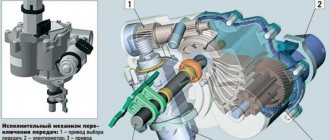As you know, various domestic models produced by AvtoVAZ have long been produced exclusively with a manual transmission. However, not so long ago the popular Lada Granta and Kalina received the long-awaited automatic transmission, which can rightly be considered a great success.
With the launch of the Lada Vesta model on the market, many car enthusiasts, for obvious reasons, also immediately turned their attention to the version with an automatic transmission. Next, we will look at what kind of automatic transmission is installed on the Lada Vesta now, as well as what automatic transmission options may appear on this model in the future.
Vesta AT review
Since the new AvtoVAZ model went on sale, many potential buyers have test driven the 2022 Lada Vesta with a variator in car dealerships. Earlier, in the summer of 2022, a new automatic transmission was installed on the XRAY Cross, and even then the first videos of test drives of models with a CVT appeared on YouTube.
Externally, there are no differences between the manual Lada and the AT version. The body dimensions remain the same. The CVT transmission is larger in height than the manual transmission, but this did not affect the ground clearance, it remained the same - 178 mm, in the SV Cross version - 203 mm. Starting with the basic configuration, all models are equipped with protection that reduces the ground clearance by 3 cm.
A new automatic transmission is installed on the Lada Vesta along with a Japanese 1.6 liter engine. The power unit, which was developed by the Nissan concern, is produced at AvtoVAZ and has the factory designation H4M. Power 113 l/s with torque 156 rpm.
"Lada Vesta" automatic. Photo source: https://express-lada.ru/wp-content/uploads/2019/09/vesta-04-1.jpg
The model with the new engine, according to the manufacturers, should reach a speed of 100 km/h in 12 seconds. The declared average fuel consumption is 7.5 liters. A test drive of a Vesta with a CVT refutes the promises of AvtoVAZ. In practice, acceleration is 13.5 seconds, fuel consumption is 2.5 liters more.
Ergonomics and trunk
The Tolyatti Lada SW Cross grew out of a utilitarian station wagon, but in spirit it is closer to sports models. The courageous appearance is not conducive to transporting boxes of tomatoes or persimmons, as many Lada station wagons do now. The car was created for emotions and copes with this task.
Article on the topic
Million dollar car. Test drive LADA Vesta Sport
The ergonomics are well thought out. You don't feel uncomfortable here. The steering wheel stays about where you'd expect it to, and you can stick your legs so far under the steering column that you find yourself in a reclining position. There is nothing annoying in the interior, and even the dashboard and other body panels fit perfectly. There are no longer any unpleasant odors, gaps, creaking doors and other attributes of the “domestic auto industry” on modern AvtoVAZ models. Build quality has improved dramatically in the last five years, which is encouraging. French management began to restore order here.
True, the dashboard is puzzling. The numbers on the red rims of the speedometer and tachometer are poorly distinguishable, making the readings unreadable. Large arrows cover the symbols. And since digital duplication cannot be displayed on the on-board computer screen, you have to strain to understand how fast the car is going. This is inconvenient when encountering cameras, because the engine in the station wagon is powerful and it is easy to go beyond the permitted speed limit.
Photo: LADA
The seats are comfortable, there is even strong lateral support. It’s a pity that sports seats come only in expensive trim levels. The armrest is tolerable, although I would like to see it adjustable in length.
The best thing about a station wagon is the trunk. It surprises because it contains a lot of surprises. There is free space under the flat floor. It contains two organizers for small items. There you can keep rags, a warning triangle, tools, cans of auto chemicals and other useful accessories. All drawers are removable and can be easily pulled out of the trunk, as are the two panels that cover them.
Photo: LADA
If it is necessary to transport large cargo, the panels are removed, opening up a large space. The floor lowers by 15 cm. If you fold the rear seats, a spacious area appears. For example, we were able to stuff an antique sofa into the luggage compartment this way. And under the organizers, in the depths of the underground, there is a full-fledged spare tire.
Photo: LADA
CVT in Vesta AT
Jatco, part of the Nissan group, developed a new CVT in 2010 for cars with an engine capacity of up to 1.8 liters. The transmission received the full name Jatco JF015E. Over 10 years, more than 10 million boxes were produced.
On the Russian market, Jatco JF015E is installed on cars produced by Nissan, Mitsubishi. Popular models among car enthusiasts are “Captur”, “Arcana”, “Logan”, “Sandero”, which have proven themselves well on domestic roads.
Development engineers improved the transmission before installing it on AvtoVAZ models. Vesta is equipped with the Jatko JF015E variator in all trim levels, excluding the basic one. Unlike competitors' models, when choosing a CVT, the buyer does not need to pay extra for additional options.
Design features and device of the JR5 Lada Vesta gearbox
The domestic robot largely copies the boxes of the German concern ZF. The AMT actuator consists of:
- clutch activation actuator;
- speed change actuator;
- clutch forks;
- backstage for controlling gears inside the car;
- input shaft speed sensor.
The design of a typical robot with electric drive and a single clutch disc. In Europe and Asia, such technology was abandoned five years ago in favor of preselective models, but on the domestic market this is a new product.
Jatco JF015E
The Jatco JF015E continuously variable variator is a continuation of the Jatco JF011E model, installed on cars with a large engine capacity. At its core, the new box resembles an automatic transmission with two gears.
Transmission modification
A pusher type belt transmits torque to cone pulleys. The magnitude of the value changes depending on the approach of the pulleys or separation.
Salon "Lada Vesta". Photo source: https://wroom.ru/index.php?id=carpic&n=61822
The updated transmission received a two-stage planetary gear, thanks to which the size of the cones was reduced. The weight and dimensions of the box have become smaller. Regulator solenoids began to be used in the valve body.
Reliability and resource
The dimensions and weight of the JF015E, compared to its predecessor JF011E, have been reduced due to the use of a planetary gear. However, the improved box has become less reliable. The main disadvantage is sensitivity to increased loads and oil contamination.
The declared transmission resource is 120 thousand kilometers. In practice, failure of the box occurs before the deadline. The variator is sensitive to overloads. Aggressive driving - quick starts, slipping, sharp braking - significantly reduces the service life of the JF015E.
Pros of the updated transmission
A test drive of the Lada Vesta SV Cross with a CVT and Vesta AT showed the dynamic advantages of the CVT transmission:
- smooth start of movement in creeping mode without using the gas pedal;
- no jerking when accelerating;
- forward and reverse gears began to shift clearly, promptly and smoothly;
- The uphill movement is smooth, without switching delays.
The cooling of the box has been improved; this system has been integrated into a common large circuit. Transmission oil moves more easily, especially at low temperatures, which reduces the load on transmission components.
There are also advantages to repairing and servicing the box:
- low price of spare parts;
- possibility of installing non-original elements;
- A variator of this type has been well studied in car repair shops over the years of operation.
"Lada Vesta" blue. Photo source: https://vistanews.ru/uploads/posts/2020-03/1584522778_lada_vesta-1.jpg
It is possible to use spare parts from vehicles that are unsuitable for use.
Minuses
Along with the positive aspects of the transmission, the disadvantages when using a CVT gearbox are indicated:
- sensitivity to overloads, reduced service life;
- increased requirements for the quality of gear oil;
- frequent breakdowns of box components.
It is noted that, according to the instructions, cars with a CVT are prohibited from being towed for the purpose of starting the engine.
Problems during operation of Jatco JF015E
AvtoVAZ engineers have improved the box installed on the Vesta. However, problems arise when operating the variator.
Oil quality
The variator is demanding on the quality of the oil. If the ATF fluid in the box is contaminated, malfunctions may occur. The previous generation JF011E has a lubricant class of NS-2, JF015E is recommended to be filled with NS-3 grade.
The valve body of the variator is most susceptible to malfunctions associated with oil contamination. The manufacturer states that transmission fluid is filled for the entire service life of the box. However, service centers recommend checking the quality of the ATF material during each maintenance. An incomplete replacement should be carried out after a mileage of 60 thousand kilometers.
Taper bearings
Bearings mounted on the drive or driven shaft are subject to premature wear. A symptom of this malfunction is the appearance of a hum in the box. In the new model, these parts themselves have become of higher quality, but their service life remains the same.
Sun gear
This element is responsible for switching forward or reverse. The gear is welded from two parts; under increased loads, the seam may fail, which leads to transmission malfunction. Symptoms: When the handle is switched to the reverse position, the car does not move or does not move forward when position D is set.
Pump in the variator
The variator is equipped with an oil pump. When the lubricant is contaminated, the valve hangs. The pressure decreases, and the driver feels shocks and dips in traction while driving.
CVT control
A test drive of a 2022 Lada Vesta with a CVT shows that driving the car is no different from other brands with a similar gearbox. The transmission operates in two lines indicated on the handle:
- From parking position P, shift to neutral N, then to D forward or R reverse.
- While driving, you can switch from position D to manual control M, including “+” upshift or “–” downshift.
The engine starts when position P is set. When you start moving, without holding your foot on the gas pedal, the gear knob is released from the lock with a button and moved to position D or R, depending on the selected direction. The car begins to move in creeping mode.
When driving, you can switch to manual control, including a lower or higher gear. It is strictly forbidden to move the control handle to P in position D. This action can lead to damage to the box.
When stopping briefly at a traffic light or when there is a traffic jam on the road, there is no need to move the shift lever to position P or N. It is enough to keep your foot on the brake pedal.
The operating instructions impose additional requirements when using a CVT gearbox in a car:
- Slips, quick starts and sharp braking are not recommended;
- It is prohibited to tow the vehicle to start the engine;
- additional loads in the form of a trailer are allowed after running-in - reaching 2 thousand km.
It is prohibited to tow a vehicle on a flexible or rigid hitch. Emergency travel is only permitted using a tow truck.
How is the interior of a car different?
In addition to the appearance of a variator, the new product has acquired other positive options. Lada Vesta now boasts the best interior design.
For expensive trim levels the following are available: black ceiling, textile mats, pedal covers, seats with embossed combined material. In addition, the mirrors are electrically driven, and the steering wheel is equipped with a heated leather-wrapped steering wheel.
We also note the improved design of the cup holders. Previous versions did not allow cups to be stored on the go: they would fall out. The innovations affected the depth and general profile of the cup holders, which can be fully used. The problem of the door lock has also been solved: they open reliably at any incline in the road.
Test drive "Vesta AT"
The network contains a video of a test drive of a Lada Vesta with a CVT, reviews of car enthusiasts and experts, by which one can judge the driving performance of the updated AvtoVAZ model.
Movement on a variator
The ride is smooth when starting to move, the car picks up speed without jerking. Compared with the AMT transmission, the dynamic qualities of the model have improved. Dips in traction and retardation when choosing modes disappeared, the car received additional energy.
City traffic
Experts and car enthusiasts are unanimous in the opinion that the main purpose of Vesta is city travel. An engine of 113 horsepower is quite enough for acceleration within the streets of populated areas.
Review of Lada Vesta, automatic. Photo source: https://www.zr.ru/cars/vaz/media/?p=1
The CVT provides comfort when driving in traffic jams and congestion. Reduced noise and vibration.
Traffic outside the city
stated that the car will be able to accelerate to 100 km in 12.2 seconds. This figure was not achieved on the test drive. When accelerating, you need to press hard on the gas pedal, but the variator is set to a leisurely ride. When pressed incompletely, the transmission automatically reduces the rpm to 2000.
When overtaking on the highway, the car lacks dynamics. The driver needs to monitor oncoming traffic and choose the safest areas that do not require the maximum speed to change lanes.
The CVT Vesta overcomes unpaved roads without any problems. A peculiarity was noticed when driving on uneven surfaces. It is better not to stop when entering an incline. The variator can open the clutch, and you won’t be able to move; you’ll have to roll back and accelerate over the obstacle.
The developers assure that short slips in the mud will not create maximum loads on the variator; they will be reduced by a two-stage planetary gear. However, the car's operating instructions require that such situations be avoided.











